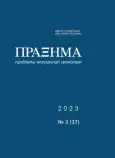Исследование посвящено визуализации, рассматриваемой как актуальная тенденция, тренд, явление современного образования и отражающей текущий визуальный поворот и новую трансформацию данной сферы. Именно современный этап визуализации образования важен и интересен для научного изучения, поскольку теоретики не успевают полноценно осмыслить все ее процессы и результаты, «миражи» (впечатляющее, поражающее воображение, но иллюзорное) и «явь» (реальное, но не всегда радостное и совпадающее с ожиданиями). Непросто спрогнозировать, но необходимо предвосхитить не только положительные, но и негативные образовательные эффекты визуализации в ходе и по итогам всплесков свершающегося на наших глазах визуального поворота в образовании, вызванных не только техническими и технологическими прорывами, но и государственной образовательной политикой, транслируемой, к примеру, в последних национальных проектах «Образование».Цель исследования состоит в том, чтобы в результате уточнения терминологического поля «визуализация в современном образовательном процессе» и характеристик состояния данной тенденции, явления в эпоху компьютерных и информационно-коммуникационных технологий выявить и обобщить очевидные и неочевидные, гипотетические преимущества, риски, недостатки визуализации в данном процессе. В исследовании последовательно решался комплекс взаимосвязанных задач, направленных на уточнение ключевых терминов, составляющих ядро «визуального поворота» и «визуализации современного образовательного процесса», определение текущего состояния визуализации образования, сопоставление аргументов и контраргументов относительно оценки позитивного влияния визуализации на современный образовательный процесс, выявление и обобщение очевидных и гипотетических преимуществ, а также рисков и негативного влияния визуализации в современном образовательном процессе, изучение возможностей визуализации для индивидуализации образовательного процесса и развития инициативности обучающихся.Методы исследования включили анализ научных источников по проблеме исследования, рефлексию собственной образовательной деятельности и опыта педагогического дизайна образовательных ресурсов, изучение научно-педагогического опыта преподавателей и государственных образовательных стандартов, метод бинарных оппозиций, обобщение и конкретизацию.В результате обобщены противопоставляемые друг другу аргументы и контраргументы относительно позитивного влияния визуализации на современный образовательный процесс, наглядно отражающие и подтверждающие недостаточную доказанность плюсов визуализации. Сопоставлены проявления «миражей» и «яви» визуализации на уровнях субъектов образовательного процесса (обучающих (учителей, преподавателей) и обучающихся (школьников, студентов)) и средств, приемов визуализации, что составляет основную научную значимость исследования. Установлено, что «миражи» характерны для всех рассматриваемых уровней, хотя в большей степени они проявляются на уровне средств, приемов визуализации. Спрогнозирован существенный потенциал дальнейшей визуализации для индивидуализации образовательного процесса и развития инициативности обучающихся как субъектов образовательного процесса.
 9-36
9-36


 37-53
37-53


 54-72
54-72


 73-89
73-89


 90-110
90-110


 111-121
111-121


 122-141
122-141


 142-158
142-158


 159-181
159-181












